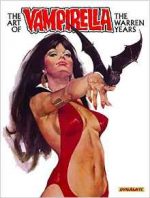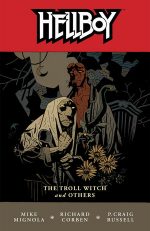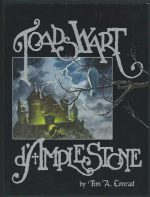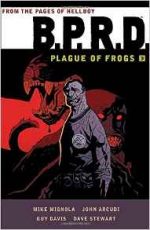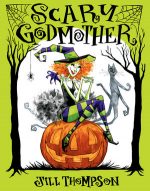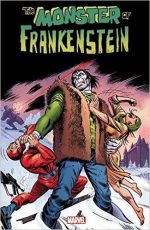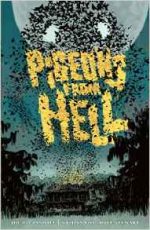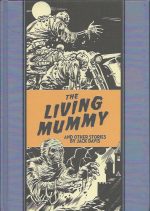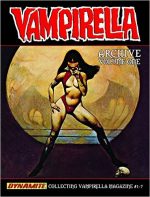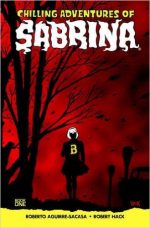
By Roberto Aguirre-Sacasa, Robert Hack & various (Archie Comics)
ISBN: 978-1-62738-987-7
Win’s Christmas Gift Recommendation: A shockingly wicked spooky story… 9/10
For nearly three quarters of a century Archie Comics have epitomised good, safe, wholesome fun but the company has always been a surprisingly subversive one.
Family friendly – and not – iterations of superheroes, spooky chills, sci fi thrills and genre yarns have always been as much a part of the publisher’s varied portfolio as the romantic comedy capers of America’s cleanest-cut teens.
As you probably know by now, the eponymous Archie has been around since 1941, but the publisher has other wholesome stars in their stable almost as well known and just as prone to radical reinterpretation.
To keep all that accumulated attention riveted, the company has always looked to modern trends with which to expand upon their archetypal storytelling brief. In times past they have cross-fertilised their pantheon through such unlikely team-ups as Archie Meets the Punisher, Afterlife with Archie and Archie Vs Predator, whilst every type of fashion fad and youth culture sensation has invariably been accommodated into and explored within the pages of the regular titles.
Following-up the stunning success of their aforementioned zombie apocalypse outing, the publishers recently took another bold and controversial step by radically reinventing saccharine sweet teen witch Sabrina.
Thus, when playwright, screen scripter and comicbook scribe Roberto Aguirre-Sacasa (whose many comics hits include The Mystery Plays, 4: Marvel Knights Fantastic Four, Stephen King’s The Stand – and Afterlife with Archie amongst others) pitched the idea to re-imagine the saucy sorceress in terms of Rosemary’s Baby and The Exorcist, it wasn’t long before a strange new enterprise was hatched.
The writer’s other scripting credits include the 2013 Carrie remake and a new version of the horror musical Little Shop of Horrors.
Archie Comics is no stranger to such material. In the 1970s the company created the sub-imprint Red Circle for anthology terror tales during a supernatural boom time, before converting the line to superhero features as the decade progressed. They even had resident witch-girl Sabrina narrating Chilling Tales of Sorcery…
The Teenaged Witch debuted in Archie’s Madhouse #22 (October 1962), created by George Gladir & Dan de Carlo as a throwaway character in a quick-fire gag anthology which was simply one more venue for comics’ undisputed kings of kids’ comedy.
Almost instantly she became a regular in the burgeoning cast surrounding core stars Archie, Betty Cooper, Veronica Lodge and Jughead Jones.
By 1969 the little enchantress had grown popular enough for her own animated Filmation TV series (just like Archie and Josie and the Pussycats), thereafter graduating to lead feature in Archie’s TV Laugh Out and finally her own title in 1971.
The first volume ran 77 issues from 1971 to 1983 and, when a hugely successful live action TV series launched in 1996, a comicbook spin-off appeared in 1997. That version folded in 1999 after a further 32 issues.
Volume 3 – simple entitled Sabrina – was based on new TV show Sabrina the Animated Series. This ran from 2000-2002 for 37 issues before a back-to-basics reboot saw the comicbook revert to Sabrina the Teenage Witch with #38. This carefully blended elements from all the previous print and TV versions.
A creature of seemingly infinite variation and variety, the mystic maid continued in this vein until 2004 and issue #57 wherein – responding to the global craze for of Japanese comics – the company switched format, transforming the series into a manga-style high school comedy-romance in classic ShÅjo manner.
That Sabrina is just a typical Greendale High School girl. She lives with her Aunts Hilda and Zelda Spellman, has a pet cat – Salem – and is tentatively dating childhood pal Harvey Kinkle. The cute but clueless boy reciprocates the affection but is far too scared to rock the boat by acting on his own desires.
Sabrina is an atypical witch: half-mortal (on her mother’s side), living in the mundane world and assiduously passing herself off as normal.
This first volume of the Chilling Adventures of Sabrina collects the shockingly adult and hard-hitting first five issues by Aguirre-Sacasa, artist and colourist Robert Hack (Doctor Who, Life with Archie, New Crusaders) and letterer Jack Morelli.
After a revelatory scene-setting Introduction from the author, the extremely nasty tale of ‘Something Wicked’ opens on October 31st 1951 in Westbridge, Massachusetts. Edward Spellman is celebrating the first birthday of his baby girl Sabrina by handing her over to a human-flesh eating, Satan-worshipping coven.
At least that was the plan: things go awry at the very last moment as his pathetic human wife Diana absconds with the infant. With dark magic at her pursuers’ command, she doesn’t get far…
By 1957 warlock Edward is out of the picture too and Sabrina is living with “aunts†Hilda and Zelda. Her birthday is a special occasion since Sabrina is given her first familiar. Salem is a very nasty cat who used to be a very nasty warlock. His current form is penance for unspoken but heinous past misdeeds…
All too soon, however, the other young witches at the secret school are bullying Sabrina over her halfbreed origins, so – after suitable reparations are set in motion – the family up stakes and move to a funeral home in bucolic Greendale. It’s 1962 and the move provides perfect cover. The little girl can refine her burgeoning powers in isolation and the constant flow of cadavers provides an income, raw materials and the occasional gustatory treat…
Life goes on and in 1964 the family grows larger as disgraced British teen warlock Cousin Ambrose moves in. He will become a dangerous, rebellious influence on the witch-in-training and when Sabrina starts human High School in September, he is constantly urging her use her powers to make life easier and more interesting…
Despite her uncanny origins Sabrina is still a girl and when she meets local hunk Harvey Kinkle, the hunky human works his own kind of magic on her, much to the dismay of mortal hottie Rosalind who claims “dibs†and doesn’t like to lose…
Sabrina’s aunts are also unhappy. She is only thirteen and must remain pure until she gives herself to Satan during her Baptism on her sixteenth birthday…
Nearby, in the deep woods, arcane events are spiralling out of control. Neophyte witches Betty Cooper and Veronica Lodge are dabbling in magic far beyond them. Horrifically they accidentally resurrect one of the most wicked of sorcerous sisters…
As seen in ‘The Secret History of Madame Satan’, unstable witch Iola was going to wed Edward Spellman, but he inexplicably dumped her for a mortal. In emotional turmoil Iola dramatically and spectacularly killed herself and her soul went to the Hell for Suicides. Now she has been accidentally called back and hungers for revenge…
She also has a natural gift for encountering nasty men and hurrying them on to their just reward…
After rebuilding her corrupted body from the flesh of innocents and vindictively divining the fates of Edward and Diana, Iola exults in learning they had a daughter. With malice in mind, “Madame Satan†turns towards Greendale and makes spiteful plans…
It’s October and as Sabrina’s birthday approaches she is more consumed with Harvey’s increasingly ardent attentions and her own theatrical ambitions and the upcoming dark Baptism…
Hilda and Zelda have been preparing Sabrina for her ‘Unholy Baptism’ for years. It will be the turning point of her life; resolving whether or not she will accede to her full powers and potential and serve the Evil One forever. Nothing must be allowed to impede or mar the crucial moment.
Sadly, it’s just not going to happen. Iola has hit town and, through arcane manipulation, inserted herself into Sabrina’s increasingly confused and conflicted life. As replacement teacher Evangeline Porter, Madame Satan even offers horny frustrated Harvey the delights Sabrina is denying him…
Culmination comes after she tricks the lad into interrupting the demon-drenched birthday Black Mass before leaves the horrified human boy to a ghastly fate…
So great is the power of witchcraft however that even death does not end the ‘Harvey Horrors’. The repercussions of Iola’s plan reverberate throughout the town and the coven, even reaching as far as Riverdale and the witches hiding there…
Although she had nothing to do with the wrecking of the baptism ritual Sabrina is then summonsed to appear before a fearsome court of witches to endure ‘The Trial’. After surreptitiously aiding Selena to escape Satanic justice, Miss Porter then delivers her sadistic coup de grace, offering the distraught teen witch everything her heart desires… or so she thinks…
Happily this is a continuing series and there’s more malevolent magic to come…
This radical makeover also offers a host of ‘Special Features’ including a ‘Cover Gallery’, variants by Hack spoofing classic movie poster such as Rosemary’s Baby, Häxan, Carrie and Creepshow, assorted retailer incentive variants by Francesco Francavilla, J. Scott Campbell and Hack, an ‘Original Sketch Gallery’ and a text feature about original Golden Age Scream Queen Madame Satan and an original exploit by Joe Blair & Harry Lucey from Pep Comics #17 (July 1941).
Brooding, slow boiling and shockingly potent – beware of profanity, gore and nudity, Archie traditionalists! – Chilling Adventures of Sabrina is a classic grown up horror story to delight hardcore far fanatics.
© 2016 Archie Comics Publications, Inc.

